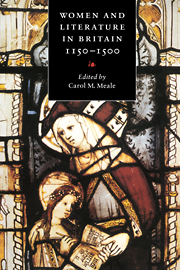Book contents
- Frontmatter
- Contents
- List of illustrations
- List of abbreviations
- Chronology: women and literature in Britain, 1150–1500
- Introduction
- 1 The power and the weakness of women in Anglo-Norman romance
- 2 Women as lovers in early English romance
- 3 Mothers in Middle English romance
- 4 ‘Clerc u lai, muïne u dame’: women and Anglo-Norman hagiography in the twelfth and thirteenth centuries
- 5 Women in No Man's Land: English recluses and the development of vernacular literature in the twelfth and thirteenth centuries
- 6 ‘Women talking about the things of God’: a late medieval sub-culture
- 7 ‘… alle the bokes that I haue of latyn, englisch, and frensch’: laywomen and their books in late medieval England
- 8 Women authors and women's literacy in fourteenth- and fifteenth-century England
- 9 Women and their poetry in medieval Wales
- Further reading
- Index of manuscripts
- Index of names and titles
8 - Women authors and women's literacy in fourteenth- and fifteenth-century England
Published online by Cambridge University Press: 09 November 2009
- Frontmatter
- Contents
- List of illustrations
- List of abbreviations
- Chronology: women and literature in Britain, 1150–1500
- Introduction
- 1 The power and the weakness of women in Anglo-Norman romance
- 2 Women as lovers in early English romance
- 3 Mothers in Middle English romance
- 4 ‘Clerc u lai, muïne u dame’: women and Anglo-Norman hagiography in the twelfth and thirteenth centuries
- 5 Women in No Man's Land: English recluses and the development of vernacular literature in the twelfth and thirteenth centuries
- 6 ‘Women talking about the things of God’: a late medieval sub-culture
- 7 ‘… alle the bokes that I haue of latyn, englisch, and frensch’: laywomen and their books in late medieval England
- 8 Women authors and women's literacy in fourteenth- and fifteenth-century England
- 9 Women and their poetry in medieval Wales
- Further reading
- Index of manuscripts
- Index of names and titles
Summary
Compilers of biographical dictionaries of early English women authors, and of anthologies of their writings, have a hard and repetitious time in their coverage of the late Middle Ages. There seems little to say, and most of it has been said already. The temptation to swell the female canon by perpetrating literary hoaxes, and to resurrect supposedly lost œuvres; has been powerful; the acclaim enjoyed by the French poems attributed to the mythical Clothilde de Surville, published by a cunning bibliophile in the eighteenth century and reprinted until as recently as the 1950s, stands as an example. But more necessary than the traditional literary-historical task of amalgamating the scattered textual remains left by female authors is some investigation of the different senses in which ‘writing women’ might have existed in the period, especially in relation to texts such as lyrics, often narrated in the female voice, whose authorship is so notoriously hard to identify. This essay accordingly focuses on some questions concerning this area of definition, and explores the possibility of isolating distinctive features of female literary composition in the centuries which immediately preceded the profound cultural changes brought about by the shift from manuscript to print culture. What kinds and standards of literacy did medieval women possess? By what methods were the compositions of women ‘authors’ recorded and disseminated, in an age when scribal skills were not automatically concomitant with authorial ones? How is it possible to locate women's writing in a period characterised by anonymity? Only by uncovering exactly what constituted women's writing can we begin to answer the most pressing questions of feminist criticism: ‘what does writing as a woman mean, and to what extent does it involve a new theory and a new practice?
- Type
- Chapter
- Information
- Women and Literature in Britain, 1150–1500 , pp. 159 - 182Publisher: Cambridge University PressPrint publication year: 1993
- 4
- Cited by

